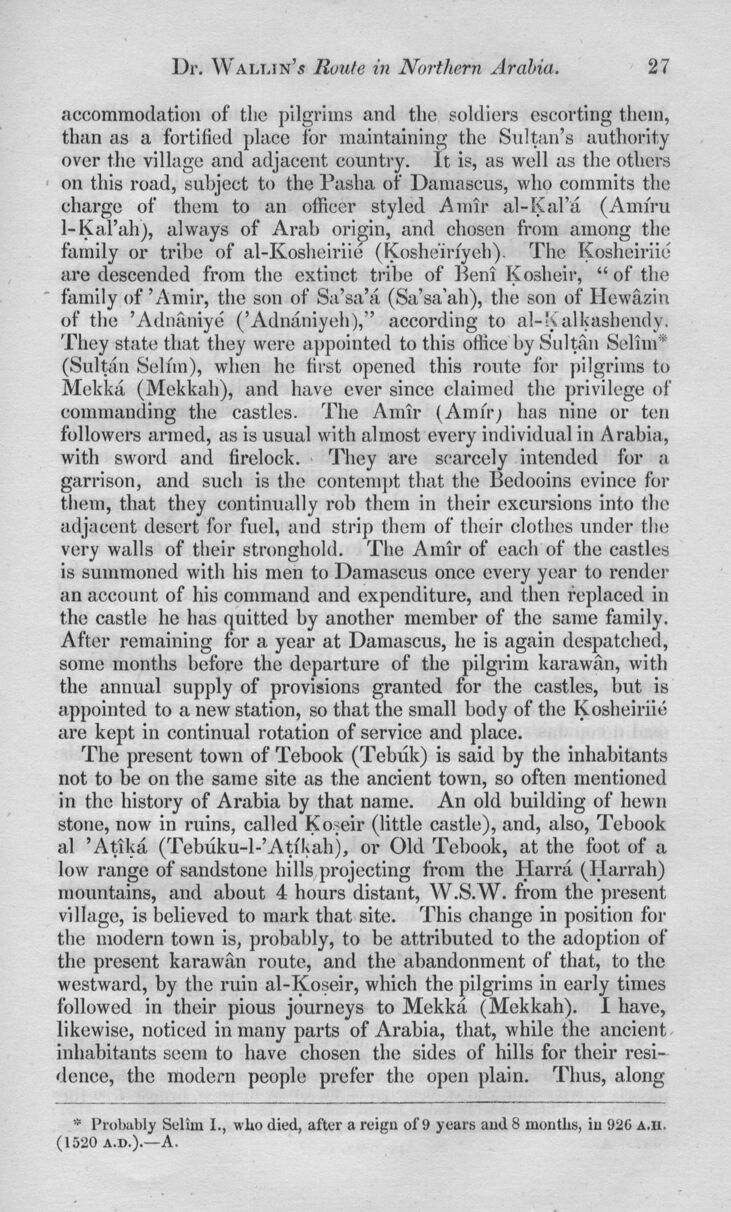
Full resolution (JPEG) - On this page / på denna sida - Route in Northern Arabia

<< prev. page << föreg. sida << >> nästa sida >> next page >>
Below is the raw OCR text
from the above scanned image.
Do you see an error? Proofread the page now!
Här nedan syns maskintolkade texten från faksimilbilden ovan.
Ser du något fel? Korrekturläs sidan nu!
This page has never been proofread. / Denna sida har aldrig korrekturlästs.
[-accommodation-]{+Dr. Wallin’s Route in Northern Arabia.
27
accommodation+} of tlie pilgrims and the soldiers escorting them,
than as a fortified place for maintaining the Sultan’s authority
over the village and adjacent country. It is, as well as the others
on this road, subject to the Pasha of Damascus, who commits the
charge of them to an officer styled Amir al-Kal’a (Amfru
1-Kal’ah), always of Aral) origin, and chosen from among the
family or tribe of al-Kosheiriie (Koshe’irfyeh). The Kosheiriic
are descended from the extinct tribe of Beni Kosheir, “of the
family of ’Amir, the son of Sa’sa’a (Sa’sa’ah), the son of Hewaziu
of the ’Adnaniye (’Adnaniyeh),” according to al-Kalkashendv.
They state that they were appointed to this office by Sultan Selim ’
(Sultan Selim), when he first opened this route for pilgrims to
Mekka (Mekkali), and have ever since claimed the privilege of
commanding the castles. The Amir (Amir; has nine or ten
followers armed, as is usual with almost every individual in Arabia,
with sword and firelock. They arc scarcely intended for a
garrison, and such is the contempt that the Bedooins evince for
them, that they continually rob them in their excursions into the
adjacent desert for fuel, and strip them of their clothes under the
very walls of their stronghold. The Amir of each of the castles
is summoned with his men to Damascus once every year to render
an account of his command and expenditure, and then replaced in
the castle he has quitted by another member of the same family.
After remaining for a year at Damascus, he is again despatched,
some months before the departure of the pilgrim karawan, with
the annual supply of provisions granted for the castles, but is
appointed to a new station, so that the small body of the Kosheiriic
are kept in continual rotation of service and place.
The present town of Tebook (Tebuk) is said by the inhabitants
not to be on the same site as the ancient town, so often mentioned
in the history of Arabia by that name. An old building of hewn
stone, now in ruins, called Ko;eir (little castle), and, also, Tebook
al ’Atika (Tebuku-l-’Atfkahj, or Old Tebook, at the foot of a
low range of sandstone hills projecting from the Harra (llamth)
mountains, and about 4 hours distant, W.S.W. from the present
village, is believed to mark that site. This change in position for
the modern town is, probably, to be attributed to the adoption of
the present karawan route, and the abandonment of that, to the
westward, by the ruin al-Koseir, which the pilgrims in early times
followed in their pious journeys to Mekka (Mekkah). I have,
likewise, noticed in many parts of Arabia, that, while the ancient
inhabitants seem to have chosen the sides of hills for their
residence, the modern people prefer the open plain. Thus, along *
* Probably Selim 1., who died, after a reigu of 9 years and 8 months, iu 926 A.H.
(1520 a.d.).—A.
<< prev. page << föreg. sida << >> nästa sida >> next page >>